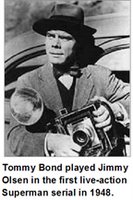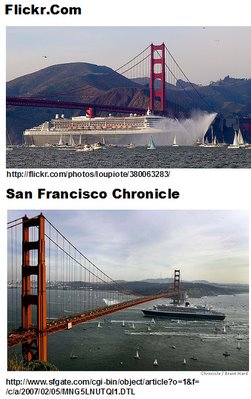You push the button, we do the rest
With almost everyone packing pixels nowadays, spot-news photographers are the most endangered species at our newspapers.
Time and again in recent years, private citizens equipped with cell phones and simple digital cameras have beaten the pros with faster, often better and frequently exclusive pictures of breaking events. The phenomenon is so common that it’s old news.
 What’s different now is that the Associated Press has established a formal relationship with NowPublic.Com, an up-and-coming repository of citizen journalism, to expeditiously deliver material deposited on its site into the hands of the mainstream media.
What’s different now is that the Associated Press has established a formal relationship with NowPublic.Com, an up-and-coming repository of citizen journalism, to expeditiously deliver material deposited on its site into the hands of the mainstream media.While citizen-generated articles will continue to require a fair amount of vetting before most outlets dare to use them, properly authenticated photos and video clips soon will flow into the mainstream news stream about as fast as stuff from accredited pros.
Because citizen shooters vastly outnumber professional journalists – and they're increasingly aware of how to get their work published – it stands to reason that they will begin scooping the pros on more and more breaking news, thus rendering staff photographers substantially superfluous. Case in point:
Having joined the crowds in San Francisco who spent Super Bowl Sunday watching the Queen Mary 2 nose under the Golden Gate Bridge, I hastened home to compare the coverage at Flikr.Com with that of the San Francisco Chronicle.
Although the Chronicle had several fine photographers stationed at key vantage points to record the arrival of the largest ship ever to enter San Francsico Bay, their shots were no better – and posted no more rapidly – than those taken by the Flikr clickers. See the two examples below.
Next time something like this happens, the Chronicle could save a ton of overtime by getting one of the local camera shops to sponsor a contest encouraging contributions from the thousands of amateurs planning to Canon-ize the spectacle. In the process, the paper would prove to readers, advertisers and – significantly – itself just how relevant it remains.
Notwithstanding the potential contribution of citizen shooters, staff photographers will be needed in the foreseeable future to shoot feature layouts, enterprise projects and perhaps the odd video. But video production requires far more than point-and-shoot skills, which at the moment may be more abundant in the citizen press corps than among most traditional still photographers.
With inexpensive auto-focus and image-stabilization cameras now widely available – and PhotoShop at hand to rescue any less-than-successful effort – even reporters could be trained to take some decent shots.
If the Speed Graphic-toting Jimmy Olsen were still around, you couldn't blame him for taking a buyout.



8 Comments:
You make a good point, as others have made along these same lines, but here's something interesting and *very* key to this discussion.
All the rights on that Flickr photo are reserved by the photographer. Do you have permission to run it, or have you stolen it?
Does the Chon have permission to run it? Can they get it in time for publication? Would they?
Also by not linking back to Flickr you've violated the Flickr useage agreement.
So perhaps Sion Touhig is right, 'Audience Stolen Content' is more accurate?
Considering the innovative multimedia and video work that photogs are doing at papers all over the world, I think they'll be sticking around -- as long as they take the time to learn a few new tricks.
"F8 and be there" ain't going to cut it.
But ... how could it be more efficient or effective for a paper to have to have editors cull through thousands of amateur's shots to find the best (and you know good photography's more than just having good focus) ... as compared with having a professional plan and execute a shot? Sure, for pure breaking news there's no substitute for simply being in the right place at the right time. But photojournalism is more than point-and-shoot, and it covers more than feature photos.
Not to mention the time spent Photoshopping pix to meet publication standards, even if we presume that's only color correction and such, not altering the images.
I disagree Alan. I don't think the flickr photo is as good as the Chronicle's. And I think citizen journalists/photographers would be better kept to social event/slideshow type stuff. They get stuff fast and can give it to you fast, but they will never really deliver the quality that a journalist can. Do you think that Suzie Nobody who went to an event can write and edit as well as you? Why do you think Joe Photo can then?
MP
Rubbish.
I'm a newspaper photographer. My job may be threatened, but not because of amateurs shooting breaking news. Spot news, even other types of news, makes up so little of most daily grind photojournalists' days that it is almost insignificant. Features, portraits, illustrations, press conferences, kids in school, business people in front of computers, that is what 90% of press photographers spend 90% of their time doing each day. You don't find that on flickr. And amateurs have been awarded Pulitzers - PULITZERS - on two or three occasions or more, all before the internet. No one lost jobs over that then.
I'm employed because I make good pictures out of mundane situations. The Queen Mary 2 comes to town? Yeah, grandma can shoot a 'publishable' picture. But can she make an almost flattering image of the stuffed suit in a cubicle?
I believe it is fair use to reproduce the Flickr image above. For a fuller discussion of the rules of fair use, please see http://newsosaur.blogspot.com/2005/03/afp-case-perils-all-online-publishers.html.
Is it fair use because it's the focus of the story?
I've been a newspaper photographer since the early 1970's. I love good images. They used to matter. But not as much today.
If you believe they do you seriously don't get it.
The audience now happily accepts "good enough" and simply doesn't marvel over how amazing a photograph of a guy in a cubicle is. They don't care.
Editors don't have to "cull through" images on Flickr...often as not they are sent directly to blogs.
So spot news, meetings, often even sports are being covered by enthusiastic amateurs. Is the coverage steady and reliable? No..but the COSTS associated with electronic only publishing are so low it doesn't matter.
If you believe that the QUALITY is what brings in and keeps readers you are wrong. Life Magazine had outstanding quality and could not survive...but People, Us, and a dozen more "celebrity news" magazines survive. Not on quality.
As a culture we are now almost entirely driven by
Adrenaline, Sex, & Politics. When you can mix the three you have massive numbers (see political sex scandals or Tiger Woods)...
Online, because banner ads are so cheap and sold on a cost per thousand basis, you need massive numbers to make them pay off. Print is declining so rapidly it's almost beyond belief...(see the New York Times sales projections issued February 10th).
So...We could clone Weegee, and blend in the DNA of Neil Leifer, Ernst Haas and Alfred Eisenstadt with a soupcon of Henri Cartier Bresson turn the end product loose as a photographer and it still wouldn't produce a huge gain in views if the competition had photos of Paris Hilton in a bikini having a nipple slip. Sorry...I know you may feel otherwise and WISH that people would flock to quality but they just DON'T.
Post a Comment
<< Home